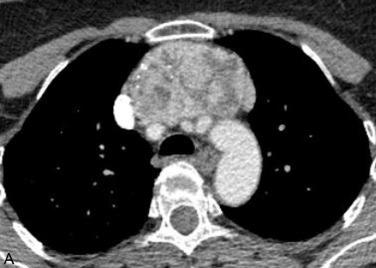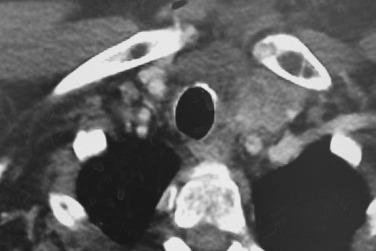Physical Address
304 North Cardinal St.
Dorchester Center, MA 02124
It is not uncommon that resection of thyroid or parathyroid pathology requires entry into and exploration of the mediastinum. Although resection can often be achieved through a transcervical approach, surgeons treating thyroid and parathyroid diseases must be familiar with thoracic approaches to the mediastinum and the circumstances under which it might benefit to seek the involvement of a cardiothoracic surgeon either preoperatively or intraoperatively. In this chapter, the indications for an extracervical approach to the mediastinum will be reviewed as well as an overview of the various types of thoracic incisions and their uses (see Chapter 6 , Surgery of Cervical and Substernal Goiter).
A thoracic approach to the mediastinum may be necessary to treat either benign or malignant conditions. Several groups have published their experiences with resection of mediastinal pathology due to thyroid or parathyroid disease. Monchik et al. reported that 29% of patients who underwent resection of a mediastinal thyroid mass required a thoracic approach, including full sternotomy, partial sternotomy, or posterolateral thoracotomy, whereas the remainder underwent successful transcervical resection. Our own experience would suggest that this is a high estimate, with well under 10% needing a thoracic approach. Indications for surgery included benign goiter, aberrant thyroid tissue, papillary carcinoma, substernal goiter, follicular carcinoma, or reoperation for either benign or malignant disease.
The most common indication for mediastinal exposure for thyroid disease is the presence of a substernal goiter ( Figure 7.1 ). Substernal, retrosternal, or intrathoracic goiters are commonly defined as having at least 50% of their mass below the thoracic inlet. Alternate definitions that have been used in the literature include a gland extending 3 cm below the sternal notch or extending below the fourth thoracic vertebra. The incidence of substernal goiter is reported to range between 0.2% and 0.5% of the general population and 0.2% and 45% of all patients undergoing thyroidectomy. This tissue may arise as an extension of the cervical thyroid, sharing its vascular supply with the main thyroid gland (secondary mediastinal thyroid goiters), or it may arise independently of the cervical thyroid gland, as a result of ectopic thyroid tissue that migrated to a mediastinal location during embryogenesis (primary mediastinal thyroid goiters). In the latter case, the arterial supply can be separate from that of the cervical thyroid gland and arises from the internal thoracic vessels. Primary thyroid goiters comprise roughly 1% of mediastinal goiters, with the vast majority being secondary in nature. The majority of secondary goiters lie in the anterior mediastinum, with only 10% to 15% located in the posterior mediastinum.

Substernal goiter can be suspected if the inferior border of the thyroid gland cannot be palpated in the neck on physical examination. Alternatively, it may be found on workup of associated symptoms resulting from compression of adjacent structures by the substernal mass, including dyspnea, dysphagia, insomnia, hoarseness, and facial swelling from superior vena cava syndrome. Workup of suspected substernal goiter should include imaging by computed tomography (CT; see Figure 7.1 ). This imaging provides essential information regarding the location of the substernal mass and its relationship to critical mediastinal structures, including the aortic arch, superior vena cava, innominate vein, esophagus, and mediastinal trachea. Magnetic resonance imaging (MRI) may be obtained to provide further information about the relationships between soft tissue structures, but it is often not required preoperatively. Although final determination of whether a thoracic surgical approach is necessary is often not possible until intraoperative evaluation, close examination of the CT scan should provide a reasonable assessment of whether an extracervical approach to the mediastinum may be required for complete resection. The most commonly reported factor to suggest successful transcervical approach for resection of a substernal goiter is maintenance of intact fascial planes surrounding the gland on preoperative CT scan, which suggests that the gland may be gently lifted out of the thoracic inlet and dissected free from the inferior parathyroid glands and the bilateral recurrent laryngeal nerves through a standard collar incision. However, blind substernal dissection of a gland that is fixed or does not lift out of the mediastinum with only gentle traction predisposes to hemorrhage or damage to the recurrent laryngeal nerves and other adjacent structures, and should not be performed in favor of a thoracic approach. Additional tools that may assist with preserving a transcervical approach include the use of a spoon, a Foley balloon catheter, and, rarely, morselization.
Several factors have been reported to increase the likelihood of needing a thoracic approach and include: size larger than the thoracic inlet; location within the posterior mediastinum; proximity to the tracheal bifurcation or aortic arch; compression of the superior vena cava, trachea, or esophagus; recurrent goiter; reoperative surgery; or malignancy with suspicion of involvement of adjacent structures. In our institutional experience, 3% of patients undergoing resection of a substernal goiter required a partial or full sternotomy. The only case requiring a full sternotomy in our series was a patient who had undergone previous resection of a goiter through a posterolateral thoracotomy. In that case full sternotomy was required to safely remove the recurrent goiter because of the massive size, location, and previous operation.
Malignant thyroid masses extending into the mediastinum are much less common than benign goiters but can require a thoracic approach for resection due to adherence or local invasion into adjacent structures. Indications that a thoracic approach may be necessary from preoperative imaging are similar to those for substernal goiter, and include size, proximity to or compression of critical mediastinal structures, and obliteration of encapsulating fascial planes. Monchik et al. reported that 56% of their cases requiring a thoracic approach for thyroid pathology had a malignant neoplasm, whereas Nervi et al. reported only 20% of their cases that required mediastinal exposure had malignant disease. Although any thyroid malignancy may extend into the chest, the most common pathologies mirror those affecting the thyroid gland, including papillary and follicular carcinoma.
Posterior mediastinal goiters represent roughly 10% of all substernal goiters and are more common in women and in patients over 50 years of age. Posterior mediastinal goiters result in complex vascular and especially neural relationships that must be clearly understood regardless of the surgical approach; these will be reviewed in detail elsewhere in this text (see Chapter 6 , Surgery of Cervical and Substernal Goiter). Although benign goiters in the posterior mediastinum are less likely, they are more likely to be symptomatic than anterior intrathoracic goiters. Patients may present with a palpable or visible cervical mass on physical examination and report symptoms resulting from compression of adjacent structures, including the trachea and esophagus. These symptoms include dyspnea on exertion or when supine, stridor, hoarseness, and dysphagia. Migration of the mass into the thoracic inlet can cause Pemberton’s sign, with facial flushing or a choking sensation with arms raised and may occur also when the patient is supine. Patients may develop Horner’s syndrome due to compression of the sympathetic chain, or jugular venous distention, thrombosis, cerebrovascular steal syndrome, or superior vena cava syndrome if the mass compresses mediastinal venous structures. When identified, these masses should routinely be resected, even in the absence of symptoms, given the risk for development of compressive symptoms with continued growth. They are often continuous with the cervical thyroid gland and can usually be excised through a cervical incision. In the largest published series to date, DeAndrade et al. reported that out of a total of 9100 patients with goiters, 1300 (14.2%) had intrathoracic lesions, with only 128 located within the posterior mediastinum. In this series, all of these goiters were removed through a transcervical approach and did not require thoracic exposure. Nevertheless, familiarity with thoracic approaches is beneficial should the need arise for enhanced exposure intraoperatively, either for complete dissection, or in the case of inadvertent injury to adjacent vessels, nerves, or to the aerodigestive structures.
Mediastinal lymph node metastasis is exceedingly rare in the setting of thyroid and parathyroid carcinomas, which more frequently metastasize to the nodes of the central or lateral neck compartments. In the series by Zhang et al., out 17,745 patients undergoing thyroidectomy for cancer, only 73 underwent mediastinal lymph node dissection through either a cervical or thoracic approach. The majority of these patients underwent transcervical dissection, with only three requiring sternotomy. Of these patients, 82.2% had papillary thyroid cancer, 16.4% had medullary thyroid cancer, and 1.4% had anaplastic thyroid carcinoma. The vast majority of these patients also had positive central or lateral nodes, with only 2.7% having positive nodes solely in the mediastinum. Patients requiring thoracic access for resection underwent full sternotomy for complete lymph node dissection, which is consistent with other reported series, where full or partial sternotomy seem to be the favored approaches for resection of metastatic mediastinal nodes in the setting of thyroid carcinoma. Predictive factors for mediastinal lymph node involvement remain controversial but include poorly differentiated tumors, bilateral cervical metastases, and distant metastases.
Thoracic access may also be required to completely access enlarged level IV lymph nodes that extend below the level of the clavicle and may involve the jugular, subclavian, or innominate veins ( Figure 7.2 ). This can be accomplished through partial sternotomy, with or without resection of the clavicular head, or through a trapdoor incision with elevation of the clavicle and first and second ribs away from the remainder of the chest wall. Potential need for a thoracic approach for mediastinal exposure is often suggested from preoperative CT or positron emission tomography (PET) imaging, although intraoperative evaluation remains the final determinant.

Become a Clinical Tree membership for Full access and enjoy Unlimited articles
If you are a member. Log in here